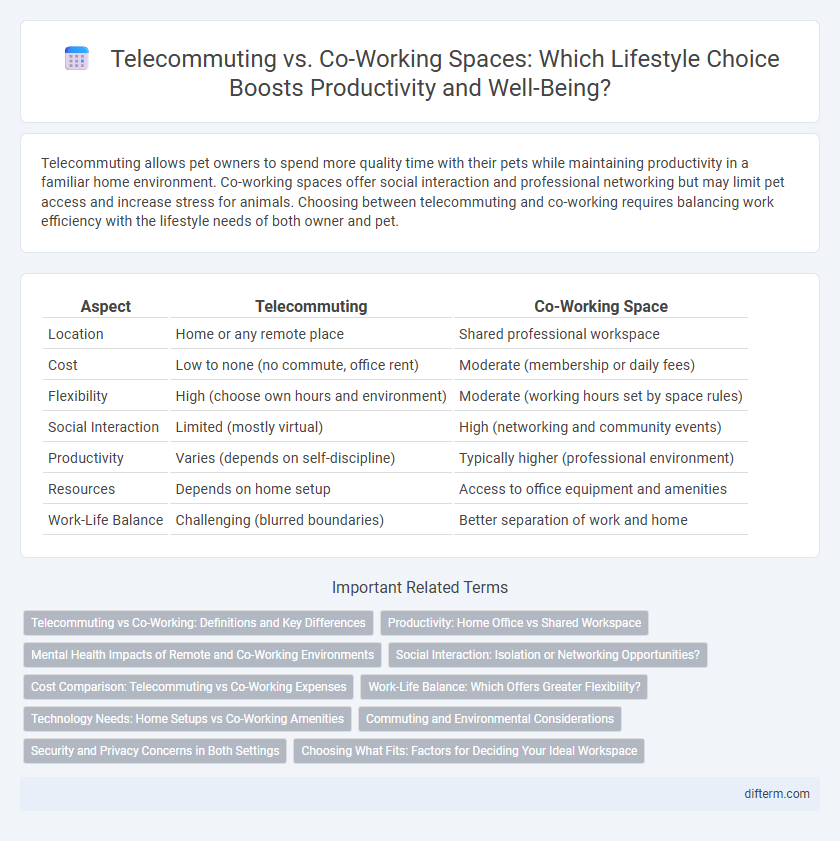Telecommuting allows pet owners to spend more quality time with their pets while maintaining productivity in a familiar home environment. Co-working spaces offer social interaction and professional networking but may limit pet access and increase stress for animals. Choosing between telecommuting and co-working requires balancing work efficiency with the lifestyle needs of both owner and pet.
Table of Comparison
| Aspect | Telecommuting | Co-Working Space |
|---|---|---|
| Location | Home or any remote place | Shared professional workspace |
| Cost | Low to none (no commute, office rent) | Moderate (membership or daily fees) |
| Flexibility | High (choose own hours and environment) | Moderate (working hours set by space rules) |
| Social Interaction | Limited (mostly virtual) | High (networking and community events) |
| Productivity | Varies (depends on self-discipline) | Typically higher (professional environment) |
| Resources | Depends on home setup | Access to office equipment and amenities |
| Work-Life Balance | Challenging (blurred boundaries) | Better separation of work and home |
Telecommuting vs Co-Working: Definitions and Key Differences
Telecommuting involves working remotely from home or any location outside a traditional office, leveraging digital tools to maintain productivity. Co-working spaces are shared, professional environments where individuals from different companies work alongside each other, fostering networking and collaboration. Key differences include telecommuting's flexibility and solitude versus co-working's structured setting and social interaction.
Productivity: Home Office vs Shared Workspace
Telecommuting in a home office offers personalized environments that reduce distractions and enable tailored productivity routines, enhancing focus and efficiency. Shared workspaces foster collaboration and networking opportunities, which can boost creativity but may also introduce noise and interruptions that hinder concentration. Balancing the quiet and control of home offices with the dynamic atmosphere of co-working spaces is key to maximizing productivity based on individual work styles.
Mental Health Impacts of Remote and Co-Working Environments
Remote telecommuting often reduces stress by eliminating commuting time and providing a personalized workspace that can enhance focus and work-life balance. In contrast, co-working spaces foster social interaction and collaboration, which can alleviate feelings of isolation and improve mental well-being. However, co-working environments may introduce distractions and noise, potentially increasing cognitive fatigue and stress for some individuals.
Social Interaction: Isolation or Networking Opportunities?
Telecommuting often leads to social isolation due to limited face-to-face interactions, impacting mental health and collaboration. Co-working spaces provide dynamic environments that foster networking opportunities and spontaneous connections among diverse professionals. Choosing between the two depends on the value placed on social engagement versus the flexibility of remote work.
Cost Comparison: Telecommuting vs Co-Working Expenses
Telecommuting significantly reduces monthly expenses by eliminating commuting costs and minimizing daily expenditures on food and professional attire, while co-working spaces typically charge membership fees ranging from $100 to $600 per month depending on location and amenities. Fixed costs of telecommuting include home office equipment and increased utility bills, whereas co-working spaces provide infrastructure, networking opportunities, and often include utilities, internet, and office supplies in their fees. For freelancers and remote workers, telecommuting presents a cost-efficient solution with lower overhead, contrasted by co-working spaces that offer communal benefits but at higher recurring costs.
Work-Life Balance: Which Offers Greater Flexibility?
Telecommuting allows individuals to tailor their work environment and schedule, promoting a seamless integration of personal and professional responsibilities that enhances work-life balance. Co-working spaces provide structured environments with opportunities for social interaction and networking, which can reduce isolation but may introduce fixed hours that limit flexibility. Evaluating personal preferences and job demands is crucial to determining which option better supports individual work-life balance goals.
Technology Needs: Home Setups vs Co-Working Amenities
Telecommuting requires a robust home technology setup, including high-speed internet, reliable hardware, and secure VPN access to ensure productivity and data protection. Co-working spaces offer advanced amenities such as high-capacity Wi-Fi, shared printers, video conferencing rooms, and technical support, enhancing collaboration and reducing individual setup costs. The choice between home setups and co-working amenities depends largely on the specific technological demands of the job and personal preferences for work environment.
Commuting and Environmental Considerations
Telecommuting eliminates daily commuting, significantly reducing carbon emissions and traffic congestion associated with traditional office commutes. Co-working spaces, while requiring some travel, often leverage centralized locations accessible by public transit, decreasing individual car use and supporting urban sustainability. Both options contribute to lower environmental impact compared to conventional commuting, with telecommuting offering the highest potential for reducing transportation-related pollution.
Security and Privacy Concerns in Both Settings
Telecommuting offers greater control over data security by enabling individuals to use private, encrypted networks and personal devices, reducing exposure to external threats. Co-working spaces pose increased risks due to shared Wi-Fi networks and communal areas, which can lead to potential data breaches and unauthorized access. Implementing strong cybersecurity measures such as VPNs and multi-factor authentication is essential to protect sensitive information in both environments.
Choosing What Fits: Factors for Deciding Your Ideal Workspace
Choosing between telecommuting and co-working spaces depends heavily on productivity preferences, social interaction needs, and work-life balance priorities. Telecommuting offers flexibility and comfort for those who thrive in a personalized environment, while co-working spaces provide networking opportunities and a structured routine that can enhance focus. Evaluating factors such as noise levels, collaboration potential, and commute time helps determine the optimal workspace tailored to individual lifestyle and professional goals.
telecommuting vs co-working space Infographic

 difterm.com
difterm.com